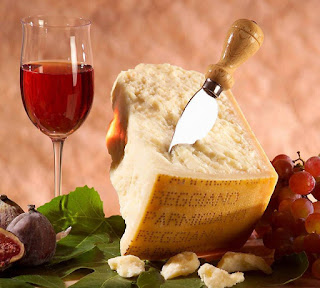PRESENTATION Entreprise créée en 2005, LA TRIDIAL IMPORT - EXPORT a longuement travaillé à diversifier ses produits dont voici une liste dans laquelle vous trouverez une vaste gamme de produits essentiels pour une cuisine imaginative et creative, goût sain et équilibré, le tout certifié par l’universel « MADE IN ITALY ».
sabato 7 novembre 2015
COME SI ASSAGGIA IL PARMIGIANO REGGIANO
Gli strumenti impiegati durante l’assaggio sono i cinque sensi: vista, udito, olfatto, gusto e tatto e, per individuare tutte le sfaccettature della complessità sensoriale del Parmigiano Reggiano, è necessario farne un adeguato addestramento . La vista
Ancora prima di assaggiare il Parmigiano Reggiano, la vista provoca stimoli sensoriali.
L’aspetto esteriore è importante e garanzia di una buona conservazione del prodotto.
Forma, dimensioni, aspetto e colore sono stimoli visivi importantissimi.
L’udito
Nella degustazione, gli stimoli sonori fanno apprezzare la friabilità della pasta.
L’olfatto
Fra i sensi è il più sottile: indispensabile per captare tutti gli odori e gli aromi del Parmigiano Reggiano anche durante la masticazione.
Il gusto
La lingua, la bocca e la gola sono i nostri strumenti per assaporare il Parmigiano Reggiano. La lingua è un sensore importantissimo sia per le percezioni tattili, sia per quelle chimiche (sapori). I gusti fondamentali sono quattro: dolce, salato, acido e amaro che si manifestano in successione temporale.
Il tatto
Solo toccando e masticando il Parmigiano Reggiano si possono comprenderne la struttura e la consistenza.
In questo modo si possono valutare le caratteristiche di compattezza, durezza, elasticità, granulosità, friabilità e di temperatura che possono influenzare il gradimento del formaggio.
LA PROCEDURA DELL’ASSAGGIO
Per assaggiare al meglio il Parmigiano Reggiano occorre seguire questi semplici passaggi:
osservare la scaglia o il campione di Parmigiano Reggiano
prenderlo fra le mani e tastarlo
spezzarlo e annusarlo valutandone gli odori
mordere il pezzetto e deformarlo con i denti
masticarlo, facendolo ruotare in tutto il cavo orale
espirare l’aria dal naso e valutare aroma e persistenza globale
valutare l’intensità dei sapori fondamentali
distinguere le caratteristiche della struttura del formaggio percepite in bocca
deglutire il campione e valutare l’eventuale comparsa di retrogusti .Comment déguster L'Parmigiano Reggiano
Les instruments utilisés lors de la dégustation sont les cinq sens: la vue, l'ouïe, l'odorat, le goût et le toucher et d'identifier toutes les facettes de la complexité sensorielle de Parmigiano Reggiano, vous devez faire une formation adéquate. La vue
Même avant la dégustation Parmigiano Reggiano, la vue provoque des stimuli sensoriels.
L'aspect extérieur est importante et garantit une bonne conservation du produit.
Forme, la taille, l'apparence et la couleur sont des stimuli visuels importants.
Audition
En dégustation, les stimuli sonores sont appréciés le croustillant de la pâte.
Odeur
Parmi les sens est le plus mince: essentielle pour capturer toutes les odeurs et les arômes de Parmigiano Reggiano également lors de la mastication.
Le goût
La langue, la bouche et la gorge sont nos outils pour savourer Parmigiano Reggiano. La langue est un capteur très important pour les deux perceptions tactiles, à la fois pour les produits chimiques (saveurs). Les quatre saveurs de base: sucré, salé, acide et amer qui se produisent dans la succession temporelle.
Sentir
Seulement toucher et mâcher Parmigiano Reggiano peut comprendre sa structure et la texture.
De cette façon, vous pouvez évaluer les caractéristiques de taille compacte, la dureté, l'élasticité, le gravier, la friabilité et la température qui peuvent affecter la popularité du fromage.
La dégustation de PROCÉDURE
Pour déguster le meilleur Parmigiano Reggiano doit suivre ces étapes simples:
observer l'échelle ou un échantillon de Parmigiano Reggiano
le prendre dans ses mains et tastarlo
briser et sentir les odeurs de cotisation
mordre la mèche et se déformer avec des dents
mâcher, tournant autour de la bouche
expirez l'air par le nez et évaluer l'arôme et persistante mondiale
évaluer l'intensité des saveurs de base
distinguer les caractéristiques de la structure du fromage perçue en bouche
avaler l'échantillon et d'évaluer la survenance de tout arrière-goût.
HOW TO TASTE THE Parmigiano Reggiano
The instruments used during tasting are the five senses: sight, hearing, smell, taste and touch and to identify all facets of sensory complexity of Parmigiano Reggiano, you must make a proper training. The sight
Even before tasting Parmigiano Reggiano, the view causes sensory stimuli.
The outward appearance is important and guarantee a good conservation of the product.
Shape, size, appearance and color are important visual stimuli.
Hearing
In tasting, the sound stimuli are appreciated the crispness of the dough.
Smell
Among the senses is the thinnest: essential to capture all the smells and aromas of Parmigiano Reggiano also during chewing.
The taste
The tongue, mouth and throat are our tools to savor Parmigiano Reggiano. Language is a very important sensor for both tactile perceptions, both for those chemicals (flavors). The four basic tastes: sweet, salty, sour and bitter that occur in temporal succession.
Feel
Only touching and chewing Parmigiano Reggiano can understand its structure and texture.
This way you can evaluate the characteristics of compact size, hardness, elasticity, grit, friability and temperature that can affect the popularity of the cheese.
THE PROCEDURE tasting
To taste the best Parmigiano Reggiano must follow these simple steps:
observe the scale or sample of Parmigiano Reggiano
take it in his hands and tastarlo
break and smell assessing odors
bite the bit and deform with teeth
chew, turning it around the mouth
exhale air from the nose and evaluate aroma and persistent global
evaluate the intensity of basic tastes
distinguish the features of the structure of the cheese perceived in the mouth
swallow the sample and evaluate the occurrence of any aftertaste.
Iscriviti a:
Commenti sul post (Atom)




Nessun commento:
Posta un commento